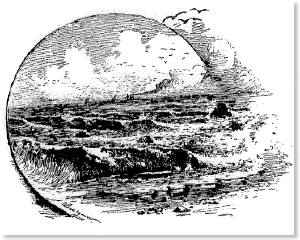|
Adolph Sutro (1830-1898)
Adolph Heinrich Joseph Sutro was born April 29, 1830. He was well educated in the field of mining engineering. Sutro arrived in San Francisco aboard the steamship California, in 1850, and immediately engaged in trade, first in San Francisco and, later, in Stockton. In 1859, when the Comstock Lode made headlines, he was again attracted to mining. He established a small mill, called the Sutro Metallurgical Works, in East Dayton, Nevada, for the reduction of ores by an improved process of amalgamation and was responsible for the planning and building of the Sutro Tunnel. This tunnel made it possible to drain and ventilate the many mines in the Comstock Lode, and to permit the miners to bring out the rich silver ore.
In 1894 he ran for mayor on the Populist ticket and served one two-year term, and was succeeded by James. D. Phelan. At one time Adolph Sutro owned one-twelth of the acreage of San Francisco. he purchased the Cliff House in the early 1880s, and one thousand acres of land facing the ocean, now called Sutro heights. He built the Sutro saltwater baths and planted Sutro Forest. He owned the finest private libary in America, much of which was destroyed during the fire that followed the Great Earthquake of 1906. Sutro died in San Francisco August 8, 1898. Art illustration for this book is by Carl Dahlgren (1841-1920), a San Francisco artist. Little is known about Eugenia Kellog Holmes. The California State Library system holds only this work written by her. ADOLPH
SUTRO by Eugenia Kellogg Holmes Illustrated by Carl Dahlgren
By
the birth of that son, the City of San Francisco, the State of California,
and the world Amid
scenes and associations unparalleled in historic trophies, the youthful
years of this scion of the sterling virtues were passed; for Aix-la- Certain it is, that Aquis Granum became a favorite resort of the Romans, who first sought it for the natural sulphur springs abounding there, renowned for their alleviation of varied infirmities, among them acute cases of rheumatism and gout. This was long before the advent of the Emperor Charlemagne, who endowed it with added dignity by making it, during his dynasty, the first city in the Empire and the capital of all his dominions North of the Alps. A magnificent mausoleum there marks his remains; his statue, in bronze, adorns the market place; his fountain sprays the bearded trees; planted it is said, by him. The chapel where he worshipped, and where repose his remains, contains relics of reputed antiquity, which are objects of exceeding veneration by the children of the Roman Church, who assemble there in great numbers every seven years, when the relies are placed on exhibition. For
the citizens of Aix- This
wall, pierced originally by ten gates, and partially demolished by the
Hollanders, was rebuilt and strengthened by Frederick Barbarossa, whose
fondness for this Flysian of the ancients equaled that of the natives,
who were wont to say with pride, "After Rome — It was here that Napoleon the First rested, when wearied with war's rude reveilles. Long ago the vandals razed the favorite palace of Charlemagne, and upon its ruins, by way of complimentary apology, was erected Coronation Hall, where his successors, for more than seven centuries, have been crowned. Two towers, of ancient Roman origin, rear their stately battlements above the marts of manufacturers, mechanics and the kinsmen of commerce, in silent scorn, it would seem, for those usurpers of the picturesque; but the springs, where Kings loved to drink and bathe, remain unchanged. Ephen,
the favorite hunting ground of royalty, situated within the environs of
Aix-la- Though the commercial tendency of the age conduces to little reverence for the hallowed, the historic, the picturesque, yet those who are truly reflective must acknowledge the value of these mute, invisible sentinels. We are all products of the past, and with it our lives are indissolubly linked. Such sentiments seem inseparable from a study of the early life of Adolph Sutro, for as a lad, we may without elasticity of imagination, behold him alone and aloof from others of similar age; ruminating among the ruins of European rulers; delving into the intricate things of earth; scanning the mysteries of wave and wind for an intelligible answer to his earnest queries; experimenting with tangled shreds of dismembered machinery; tracing the starry constellations with a tiny telescope; such having been his youthful occupation, and as such be remains a part of the wise, serene, philanthropic, patriarchal old world. A
region of new, raw, jarring, nerve- At the age of sixteen, much to his regret, the young student left school to assume the superintendence of his father's factory. Two years later, such being his acquired competency, he was intrusted to the more important post of establishing a similar store at Menel, in Eastern Prussia. The death of Mr. Sutro, Senior, in December, 1847, increased the son's responsibility, the business by that event becoming family property, under the sole management of Adolph and his brother. But for the Revolution of 1848, which sent a shudder through Europe, menacing the securest form of government, disorganizing business and sundering the sacred ties of kindred, it is presumable that the brothers might have continued in uninterrupted prosperity the work of manufacturing cloth, after the manner of their sire. The
universal crash, however, could not but affect the firm of the Sutros.
There was no alternative— With a ready resolution and unerring breadth of vision for which she was remarkable, Mrs. Sutro decided that there was small prospect in the Fatherland, under the circumstances, for such a future as she aspired too for her family, composed of eleven children. The choice of a foreign home was deemed imperative, and the lady favored America. In the Autumn of 1850 the Sutros landed in New York, and subsequently settled in Baltimore, Maryland. It
was about this time that the California gold excitement waged most fiercely,
when armies of men forsook the fetters which civilization had forged, and
fled, with a speed impeded only by the pathless plains, the desert wastes,
the hostile savages, the treacherous winds and tides, to the far- Young Sutro readily grasped the meaning of this excitement, being among the first to take passage on a sailing vessel bound for the port of San Francisco. During this voyage, which lengthened to months, the winds being variable, the ambitious adventurer beguiled his time by writing letters, descriptive of scenery witnessed, the strange and interesting types of life encountered, and in keeping an accurate record of occurring incidents. Those letters, addressed to his mother and sisters, are still extant; their contents bespeak the same appreciation of nature, comradeship with humanity, independence of action and unswerving, lofty purpose, which has since been brought to such conspicuous fruition.
His fortune at that time consisted solely in youth (he was less than twenty), health, hope, courage, ambition and indomitable energy. With this uncurrent capital he went into business on the water front. For nine years he worked hard in what is called petty trade, buying, selling, keeping a limited supply of the best cigars and tobacco; living, as those have ever lived who toil without compensation, other than frugal food, few comforts, and the recreation which exists only in name. During
this period of time (the year 1856) Mr. Sutro married, and was thereafter
encouraged and assisted by a faithful, fond wife. "But for her,"— Six
children— All survive their mother, who died December 8th, 1893, at the Hayes and Fillmore family residence, in San Francisco. Those survivors are Mrs. Albert Morbio, Mrs. Moritz Nussbaum, Mrs. Dr. Sutro L. Merritt, Miss Clara A. Sutro, Mr. Charles W. and Mr. Edgar Sutro. Each is personally identified with some practical work, of a character largely philanthropic. From the monotony of a life devoted to domesticity and the routine of retail trade, Mr. Sutro was at length, stirred by a sensation electrifying to the Pacific Coast, and extending in its interest, to remoter regions. The occasion was the discovery of the Comstock Lode, in the State of Nevada. Mr. Sutro visited this exciting section for the first time in the year 1859, and there found the opportunity to apply the scientific knowledge gained by years of patient study. The immediate need of ventilating and draining the mines, was impressively apparent to the young man, who saw that great volumes of water impeded the progress of labor and its reasonable reward.
This thought found expression in a letter, first published in the "San Francisco Alta," April 30, 1860. "An unfeasible plan!" "The audacity of a dreamer!" sneered the pessimistic, for well they knew that a gateway through granite needed the resonance supplied by bonds and coined securities, ere the hidden treasures of the caverns would be made to surrender. The young man, whose fortune was then locked in the rigid fastnesses, heeded not the hissing voices of harpies, but, by his own individual effort, alone and unaided, secured the right of franchise to those remote recesses. His subsequent tasks were to obtain and retain the confidence of capitalists at home and abroad; to maintain control of political power in Washington, in London, and San Francisco; to make frequent marine and overland voyages extending over two hemispheres; to watch, at the same time, the progress of work at the mines, and act as their superintendent. These were Herculean tasks, combined with hazardous venture, manual toil, and diplomacy unparalleled in the history of Courts, Kingdoms or Republics. After the merits of the enterprise were fully understood and recognized, there followed even more desperate struggles to maintain it against conspiracies combined to thrust Mr. Sutro out, that others might appropriate the result of his efforts.
It was accomplished however, exactly as proposed, and occupied its originator, fourteen years of such effort as few men could have approached. The tunnel, linked inseparably with the name of Sutro, was finished October, 1878. Its dimensions were 10 feet high, 12 feet wide, 20,500 feet long, with North and South branches having 3600 feet in the aggregate, making its entire length more than five miles. Its cost, without interest, was $4,500,000; including interest, $6,500,000. From the corporation he had organized Mr. Sutro at length relinquished all monetary interest, retaining an amount to his credit of not less than $5,000,000. With it he returned to San Francisco, his favorite city, there to permanently reside. About
this time the "sand- From a close study of the soil and its varied resources, the Seer of the sand hills knew that not a rood of the yellow dunes, sprayed by the swirling surf, would one day be worth less than its weight in gold, though it was then without shred of green, or glance of rill, or glint of bloom. With the breadth of vision, unerring judgment, and prompt action which had brought the tunnel to successful completion, Mr. Sutro invested vastly in shore lands, believed, by the then doubting public to be worthless. Men
were employed for the improvement of those and acres, who, under the master's
direction, pierced the subterranean depths by shafts and pumps; sent iron
conduits through the stubborn hills in search of the needful water; blasted
the rocks and had them cut into staircases, parapets, and the walls of
lake- Millions of tender seedlings were planted in the sear spaces and gently nurtured in the plastic sands, softened by soothing water brought from the summit stores. These, Mr. Sutro calls the children of his age, for tree planting, with him, is a labor of love. Those infant forests have grown to sturdy groves which skirt the horizon with swaying leaves. Playgrounds,
especially provided for children, are on those wooded hills, as well as
reposeful places for gray- At
Sutro Heights, a superb suburb of the city of splendid eminences, situated
upon a natural walled promontory, overlooking lone Tamalpais, the mist- The
more delicate exotics, formed to flourish in tropical climes, are sheltered
from the harsh winds and dense fogs of that aerial altitude in a glass
conservatory,— The
statuary, set in the niches, terraces, parterres, parapets, along the tree-
The rich, the cultivated and traveled find there, environments of harmony, while the poor are not pained by ostentation nor cankering contrasts. Among
the visitors entertained at the white- The mailed knights at the gates are hospitable. The
snowy- Mr.
Sutro has said in public print— But Mr. Sutro does not, in his lofty eyrie, on the cliff's crest, surrender himself to the exclusive delights of entertainment. Much
of his well- This is the Sutro Library, conceded by men of the highest scholarship to be one of the four great libraries of the United States. Three, hundred thousand volumes have already been collected by agents stationed in the best Continental book marts, and additions are being constantly made. Among the rarest tomes and incunabula, may be mentioned duplicates of the early printer's art, from the famous Munich Library, four thousand in number; folios of the classics from the monastery of Boxheim and the Duke of Dahlberg, the Sunderland Library and the confiscated monasteries of Bavaria.
A
complete military, architectural and botanical library contributes its
golconda of treasure; antique and priceless scrolls from the Orient are
preserved with the parchments of Maimonides, author of "Ram Bam,"
who was called the Light of Israel, the Star of the West, and the Great
Eagle. Classics, poems, plays in all languages of the learned, are in those
closely packed cases, book- When completed, as designed, it will be accessible to every disciple of science, that being the special motive of its magnanimous founder. The structure site chosen for this colossal collection of literary treasure is in Golden Gate Park, near the music stand. It will be fire proof and free to the public. But not alone in the absorbing walks of the bibliophile, the charms of hospitality, the conflicting cares of exalted office does Mr. Sutro find entire concentration ; his active brain demands perpetual achievement. The more recent of these achievements partaking of the form of baths, which rival in magnitude, utility and beauty, the famous abluvion resorts of Titus, Caracalla, Nero or Diocletian. Those
wonderful expressions of architectural skill — This consists of a series of basins, blasted in the rock, which receive the water pure from Ocean's briny caverns, by a complete system of tunnels and canals, so ingeniously devised as to supply the receptacles with both hot and cold currents, and drain them, after use. Thus have the tides been harnessed and made subservient to the multitudes. There
are six swimming tanks, the largest being L- Four
are, each, twenty- Spring- Five
hundred dressing rooms, perfectly ventila ted, heated, lighted by electricity,
furnished with showers, soap, toweling, bathing suits and all necessary
toilet articles are reached by the aid of spacious elevators and broad
staircases, that lead likewise to arcades, pavilions, balustrades, promenades,
alcoves and corridors adorned with tropical plants, fountains, flowers,
pictures, bric- The
facade has a portico with four Ionic columns and pilasters which lead to
a noble staircase, wide, gradual of ascent, bordered with broad- This
staircase touches the very rim of the reveling waves. The foyer, on Point
Lobos avenue, is in the Greek Doric cast of architecture, and conveys those
who favor driving, to a carriage way that winds among tall terraces, rough- A distinctly noticeable feature of this stupendous establishment is a stage, constructed for the performance of operas, dramas, acrobatic exhibitions, and the display of any talent or skill contributable to public entertainment. The seats, arranged in tiers, form an amphitheatre, facing the ocean side of the structure, and are walled with glass of many colors. The most fantastic effects are caused by the filtering sun, the reaching surf, the arching sky, the curving clouds, and those radiant mosaics. Whether the sunbeams are imprisoned and tempered, the glare of electricity softened, the great, green billows are broken in snowy embroidery upon the amber sands, or ivory fogs fold the fair battlements in a fond embrace, the result is equally inspiring, incomparable and indescribable. A
seating capacity is afforded for twenty- A man, however, may build and yet not be a master architect, though his buttressed walls be as adamant, his shafts and spires and towers soar starward. That structure, surpassing mortal conception, must bear harmony with humanity, else it is like unto the "baseless fabric" of a dream. From his vast and varied creations, it might be inferred that Mr. Sutro is a man of force rather than feeling, of rigor rather than repose; but the fallacy of this inference is proven by his treatment of the poor, which is always more deferential than of the rich. So considerate of the unfortunate is this prince of finance, that he has been christened by a wag not wholly witless, the " Czar of the Scavengers." In the winter of '93, when great suffering prevailed among the indigent unemployed of San Francisco, Mr. Sutro purchased tickets from the Salvation Army to the value of eight hundred dollars, as occasion required, which were distributed, upon application, and secured to their holders a least temporary relief. His contributions to all public charity, since his arrival to opulence, have been munificent, and confined neither to race, creed nor class. His private alms are said to be limited only to the immediate needs of the individual. A
princely jpgt, consisting of twenty- Personally,
Mr. Sutro presents a rare combination of strength and simplicity — This
election is the signal of something more than an expression of sentiment.
It means a vic tory of honest elements in monopoly- The
masses, long steeped in enfeebling apathy, engendered by a piratic plutocracy
more dangerous and degrading than foreign- To
those who best know this soft- Despair is lifted to hope by his bounty. Commerce is vitalized by his energy. Hospitals claim him as their benefactor. Schools own him as their patron. Art finds in him a supporter. The feet of progress are sandaled by his silver. Invention, by his fostering patronage, has successfully wrestled with the hidden forces of nature. Science leans on him, while her starry vision scales the infinite. Patriotism sings paeans for him, who in the hour of the State's struggle, sent the ringing gold of mercy to chime with the flashing steel of valor. In the life of all enterprise, the vigor of all progress, all expansive and ennobling unfoldment contained in the history of California, the name of Adolph Sutro is inseparably identified. To such there comes no age nor death nor oblivion. |
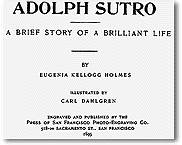 This
is the complete text of a small book published in 1895 to honor the new
mayor of San Francisco, Adolph Sutro. Sutro ran for mayor as the populist
"anti-octupus" candidate,— in opposition to the Southern Pacific
Railroad, which dominated California politics.
This
is the complete text of a small book published in 1895 to honor the new
mayor of San Francisco, Adolph Sutro. Sutro ran for mayor as the populist
"anti-octupus" candidate,— in opposition to the Southern Pacific
Railroad, which dominated California politics.
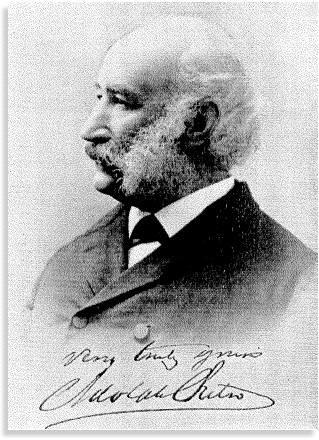 In
1879 Sutro sold his tunnel to the McCalmont Brothers, and countless lesser
investors, and returned to San Francisco.
In
1879 Sutro sold his tunnel to the McCalmont Brothers, and countless lesser
investors, and returned to San Francisco.
 At Aix-la-
At Aix-la-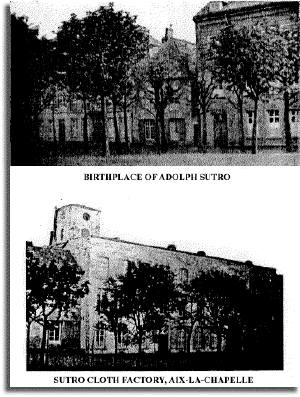 of
which these municipalities form so important a part, is enriched to a degree
inestimable, since the qualities which form nobility of character are incalculably
precious and therefore beyond the judgment of men.
of
which these municipalities form so important a part, is enriched to a degree
inestimable, since the qualities which form nobility of character are incalculably
precious and therefore beyond the judgment of men.
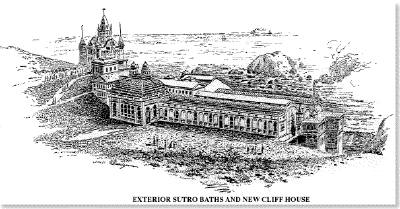 November 21st, 1851, marks the date of Mr. Sutro's arrival in San Francisco.
November 21st, 1851, marks the date of Mr. Sutro's arrival in San Francisco.
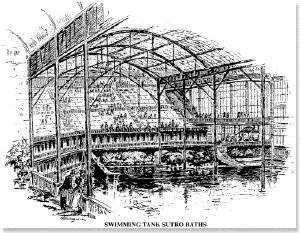
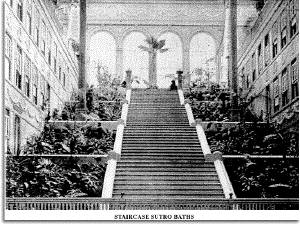 Pumping it was a costly and most precarious experiment; a depth of 1500
feet had been reached; the temperature in the lower levels was 110 degrees,
rendering work almost impossible for more than a very brief period. The
air was so foul that the men who inhaled it, fainted in those poisoned
caverns and fell—
Pumping it was a costly and most precarious experiment; a depth of 1500
feet had been reached; the temperature in the lower levels was 110 degrees,
rendering work almost impossible for more than a very brief period. The
air was so foul that the men who inhaled it, fainted in those poisoned
caverns and fell—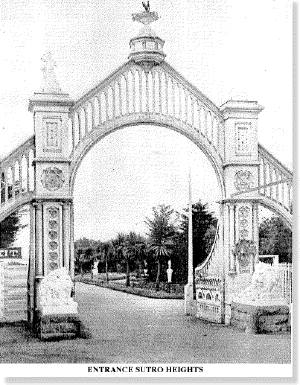 Only faith, preeminent and unswerving, in the project sought, coupled with
unremitting industry, could have carried such plans to successful completion.
Only faith, preeminent and unswerving, in the project sought, coupled with
unremitting industry, could have carried such plans to successful completion.
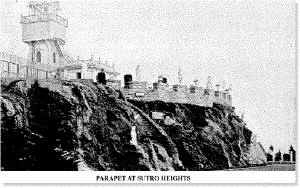 The residence, quaint and unique, is gemmed with speaking souvenirs of
Mr. Sutro's many tours in every accessible part of the world, each an expression
of taste, intelligence and appreciation for the best in human skill.
The residence, quaint and unique, is gemmed with speaking souvenirs of
Mr. Sutro's many tours in every accessible part of the world, each an expression
of taste, intelligence and appreciation for the best in human skill.
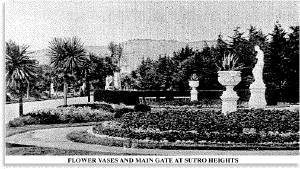 There are Mexican works, relating to the war of independence, from the
ancient archives of the Aztec capital; two thousand three hundred Japanese
manuscripts were borne from the bright land of the "Morning Calm;
" collections of Semitic philology, the chemical literature of the
late Secretary Wells, of the English Society of Industrial Chemistry, have
furnished about two thousand five hundred volumes.
There are Mexican works, relating to the war of independence, from the
ancient archives of the Aztec capital; two thousand three hundred Japanese
manuscripts were borne from the bright land of the "Morning Calm;
" collections of Semitic philology, the chemical literature of the
late Secretary Wells, of the English Society of Industrial Chemistry, have
furnished about two thousand five hundred volumes.
